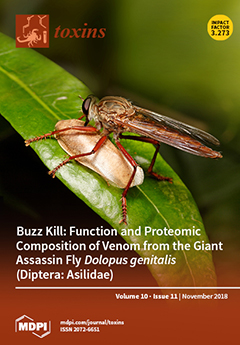Wheat, the main source of carbohydrates worldwide, can be attacked by a wide number of phytopathogenic fungi, included
Alternaria species.
Alternaria species commonly occur on wheat worldwide and produce several mycotoxins such as tenuazonic acid (TA), alternariol (AOH), alternariol-monomethyl ether (AME), and altenuene
[...] Read more.
Wheat, the main source of carbohydrates worldwide, can be attacked by a wide number of phytopathogenic fungi, included
Alternaria species.
Alternaria species commonly occur on wheat worldwide and produce several mycotoxins such as tenuazonic acid (TA), alternariol (AOH), alternariol-monomethyl ether (AME), and altenuene (ALT), provided of haemato-toxic, genotoxic, and mutagenic activities. The contamination by
Alternaria species of wheat kernels, collected in Tuscany, Italy, from 2013 to 2016, was evaluated.
Alternaria contamination was detected in 93 out of 100 field samples, with values ranging between 1 and 73% (mean of 18%). Selected strains were genetically characterized by multi-locus gene sequencing approach through combined sequences of allergen alt1a, glyceraldeyde-3-phosphate dehydrogenase, and translation elongation factor 1α genes. Two well defined groups were generated; namely sections
Alternaria and
Infectoriae. Representative strains were analyzed for mycotoxin production. A different mycotoxin profile between the sections was shown. Of the 54 strains analyzed for mycotoxins, all strains included in Section
Alternaria produced AOH and AME, 40 strains (99%) produced TA, and 26 strains (63%) produced ALT. On the other hand, only a very low capability to produce both AOH and AME was recorded among the Section
Infectoriae strains. These data show that a potential mycotoxin risk related to the consumption of
Alternaria contaminated wheat is high.
Full article






